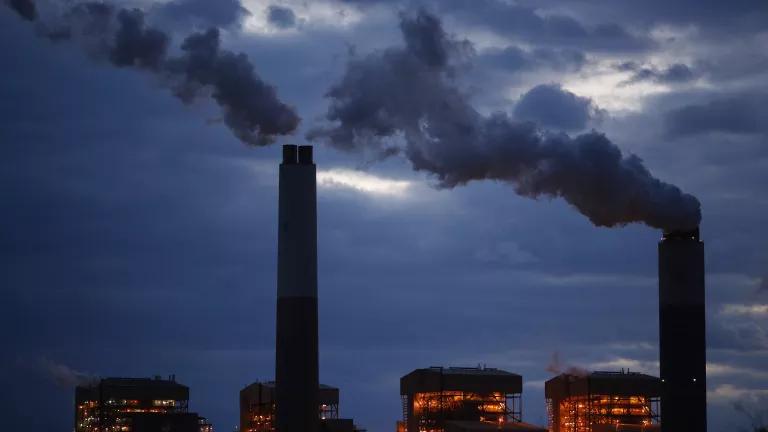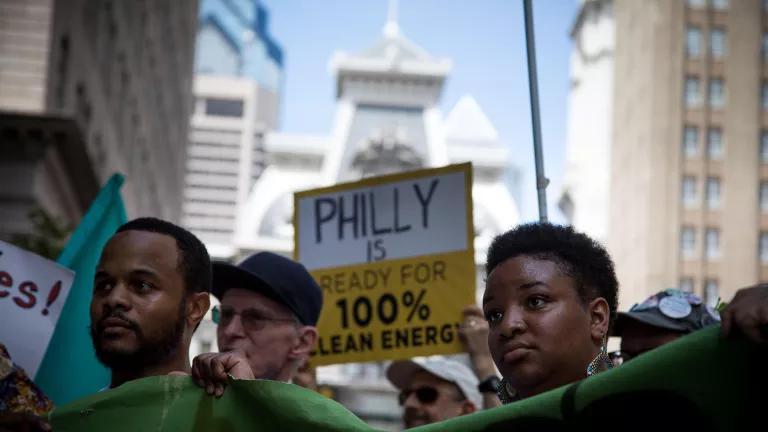Buildings: The Next Frontier for CA Clean Energy Leadership
California’s ambitious climate policies are clearing the air, cleaning up the state’s electricity supply, and getting cleaner vehicles onto the roads. But California’s residential and commercial buildings today are responsible for similar levels of climate pollution as all in-state power plants, mostly from natural gas used in furnaces and water heaters. Policymakers in California took some encouraging steps to address these emissions in 2017, but there’s much more to be done so that buildings don’t hold California back from achieving its climate and clean air goals.
Key Progress Toward Cleaning Up Building Energy Use in 2017
- Major California energy efficiency policy includes beneficial electrification. In November, the California Energy Commission (CEC) adopted a plan to implement the Doubling Energy Efficiency Savings by 2030 provision of Senate Bill 350, which sets energy efficiency targets for gas and electricity uses. For the first time, this plan includes some energy savings from substituting gas for electricity in buildings, such as for space and water heating, where this results in energy and greenhouse gas (GHG) reductions. The plan only included a fraction of the potential for cost-effective and beneficial electrification in California buildings—that is, electrification that reduces GHG emissions and consumer costs. But it is an important first step to build upon next year, particularly as California policymakers consider the potential for decarbonization of existing buildings.
- Proposed building efficiency standards could level the playing field for clean electric space and water heating. California’s current building energy code incentivizes gas-fired space and water heaters by not accounting for their higher greenhouse gas emissions and air pollution. The updated code, due to go into effect in January 2020, should reflect the advantages of today’s high-efficiency electric space and water heaters, when powered by increasingly clean electricity. The update is still in the proposal stage, but is making good progress at leveling the playing field between gas and electricity. More work is needed to ensure this and future code updates fully align with California’s climate and clean air goals.
- California Air Resource Board (CARB) resolves to support building decarbonization. On December 14, the agency tasked with achieving California’s climate and clean air goals approved an update to its Climate Change Scoping Plan that included a resolution to evaluate and pursue strategies to increase electrification in buildings where demonstrated to reduce GHGs. CARB also calls for the development and use of renewable gas, a complementary strategy to electrification, but one that is limited by the scarce supply and much higher cost of bio- and synthetic gas. The resolution rightly calls for collaboration with sister agencies CEC and California Public Utilities Commission (CPUC), which oversee building energy policy and investor-owned utility policy, respectively. However, the plan itself does not yet include specific building decarbonization strategies. This will be an important step for CARB to pursue in 2018.
- Southern California Edison (SCE) finds building efficiency and electrification to be the lowest-cost scenario for achieving climate goals. An analysis by SCE, one of California’s largest utilities, found that improving energy efficiency and using more clean electricity in buildings and transportation would allow California to achieve its 2030 climate goals at far less cost than other scenarios. SCE’s preferred pathway would use electricity to power nearly one-third of space and water heaters, in increasingly energy-efficient buildings. This is an important perspective on the feasibility and cost-effectiveness of California’s emissions and air pollution reduction goals, by a large stakeholder that plays a key role in the implementation of these policies.
- “Zero net energy” housing projects use high efficiency heat pumps for space and water heating. From new affordable family apartments in Calistoga, to farmworker housing in Cloverdale in Sonoma County, to mutual housing in Yolo County, to single-family homes in Fontana, and to low-income multi-family retrofits in the Central Valley, zero net energy housing projects across the state are demonstrating the technical feasibility and cost-effectiveness of high efficiency heat pumps for space and water heating. California’s challenge is now to scale up the use of this technology from a small share of homes and building to much of new construction and retrofits by 2030—which requires ambitious statewide and local policies.
Key Priorities for 2018 and Beyond
- Make building decarbonization a priority in California’s climate strategy. 2017’s progress, while encouraging, falls far short of the pace and scale needed to transform the building sector and achieve California’s climate goals in a cost-effective manner. The Golden State’s political leaders need to provide clear direction to state agencies to make decarbonization of the building sector a priority at the same level as the electricity grid and transportation.
- Set targets for the electrification of space and water heating in residential and commercial buildings. State leaders should launch a public process to evaluate and set targets for beneficial electrification in buildings, resulting in a comprehensive and actionable blueprint that can guide implementation and coordination across agencies.
- Remove short-term regulatory barriers to electrification. Leveling the playing field for clean electricity in the 2020 building energy code is one such effort. Other opportunities include removing barriers that hinder utilities from providing incentives for beneficial electrification projects, and offering electric rates that make heat pumps more cost-effective, just like special electric vehicle rates for EV owners.
- Provide alternative funding sources that will help building decarbonization technology come down the cost curve, just like solar panels and electric vehicles.
Cutting fossil fuel use in buildings is the next frontier in clean energy, and a major opportunity for states and local jurisdictions to demonstrate strong climate leadership. From the Northeast to the Pacific Northwest, from New York City to Boulder and Sacramento, several cities, states and regions are starting to blaze a trail in reducing fossil fuel use in buildings. At a time when the federal government has backed away from its environmental responsibilities, state and city leadership—especially California’s leadership, often a model for the nation—becomes all the more vital.



